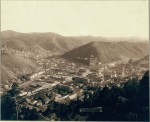 The Gold Rush boomtown of Deadwood in the Black Hills of what is today South Dakota drew thousands of people of all ethnicities to its mining industry and associated trades. By 1880, Deadwood was a well-established town, a transportation hub for the Dakota Territory and home to almost 5,000 souls making it one of the largest cities in the territory. There were Chinese immigrants in Deadwood from the beginning in the early 1870s when it was an illegal settlement in Indian territory. They set up homes and businesses clustered around the lower end of Main Street which became known as Chinatown although there were people of various ethnicities living there. Calamity Jane is said to have lived in Chinatown off and on.
The Gold Rush boomtown of Deadwood in the Black Hills of what is today South Dakota drew thousands of people of all ethnicities to its mining industry and associated trades. By 1880, Deadwood was a well-established town, a transportation hub for the Dakota Territory and home to almost 5,000 souls making it one of the largest cities in the territory. There were Chinese immigrants in Deadwood from the beginning in the early 1870s when it was an illegal settlement in Indian territory. They set up homes and businesses clustered around the lower end of Main Street which became known as Chinatown although there were people of various ethnicities living there. Calamity Jane is said to have lived in Chinatown off and on.
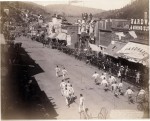 According to the 1880 census, there were 116 Chinese residents in Deadwood, more than anywhere else in the Dakota Territory, but many local historians believe the Chinese population was sorely undercounted by the census takers and that in fact it was closer to 400. The population was mostly young men in their 20s and 30s at this time, with the traditional familial structures replaced by community bonds and organizations like the Chinese Masons. Deadwood was seen initially by the Chinese as by pretty much everyone else as a temporary opportunity to make money in the mines or off the miners. This changed over the last two decades of the 19th century until by 1900 the Chinese population was half women.
According to the 1880 census, there were 116 Chinese residents in Deadwood, more than anywhere else in the Dakota Territory, but many local historians believe the Chinese population was sorely undercounted by the census takers and that in fact it was closer to 400. The population was mostly young men in their 20s and 30s at this time, with the traditional familial structures replaced by community bonds and organizations like the Chinese Masons. Deadwood was seen initially by the Chinese as by pretty much everyone else as a temporary opportunity to make money in the mines or off the miners. This changed over the last two decades of the 19th century until by 1900 the Chinese population was half women.
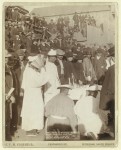 However, the overall number of Chinese residents began to decline after the passage of the Chinese Exclusion Act in 1882 which prohibited the immigration into the United States of all Chinese laborers, skilled and unskilled, and all Chinese “employed in mining.” This had a strong impact on the Chinese community of Deadwood who were mostly laborers and miners. No new workers could come to replace the deceased and the people who chose to stay could no longer bring their families to join them. Many of them returned to China rather than be parted from their loved ones forever, and others moved to cities like San Francisco with large Chinese communities.
However, the overall number of Chinese residents began to decline after the passage of the Chinese Exclusion Act in 1882 which prohibited the immigration into the United States of all Chinese laborers, skilled and unskilled, and all Chinese “employed in mining.” This had a strong impact on the Chinese community of Deadwood who were mostly laborers and miners. No new workers could come to replace the deceased and the people who chose to stay could no longer bring their families to join them. Many of them returned to China rather than be parted from their loved ones forever, and others moved to cities like San Francisco with large Chinese communities.
By 1900, the census recorded only 73 Chinese residents of Deadwood, and they were rapidly aging (the mean age in 1880 was 30.6; in 1900 it was 39.4). Observing their cultural funerary traditions had always been important, but perhaps even more so now that the small community was getting older and dying. In  1908, the Chinese residents built a ceremonial altar and burner used in funerary rituals and ancestor worship in Section Six of Deadwood’s Mt. Moriah Cemetery. The altar was in regular use for the next two decades, but fell into disrepair in the 1930s with the Chinese community in its death throes. Ching “Teeter” Ong, the last of the original Chinese Deadwoodians, left in 1931 after living there for 45 years. In the 1940s, the burner and altar were destroyed leaving behind only the concrete pad on which it had been built.
1908, the Chinese residents built a ceremonial altar and burner used in funerary rituals and ancestor worship in Section Six of Deadwood’s Mt. Moriah Cemetery. The altar was in regular use for the next two decades, but fell into disrepair in the 1930s with the Chinese community in its death throes. Ching “Teeter” Ong, the last of the original Chinese Deadwoodians, left in 1931 after living there for 45 years. In the 1940s, the burner and altar were destroyed leaving behind only the concrete pad on which it had been built.
In 2003, the Deadwood Historic Preservation Commission excavated the site of the altar hoping to find out more about the Chinese community’s mortuary rituals. Devastatingly, just two years later one of the only remaining original structure from Deadwood’s Chinatown, the building that once housed the Wing Tsue Emporium, was illegally demolished by the property owner Gene Johner. This caused enormous controversy and upset in Deadwood which is very keen to preserve its historic character.
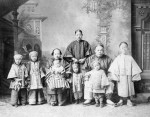 Wing Tsue, meaning “Assembly of Glories,” was a thriving shop located at 566 Main Street which carried luxury imports like silk, tea, porcelain and a large assortment of Chinese foods and herbs. (See this entry about the Golden Flower of Prosperity Company in Oregon for a fascinating example of Chinese retail from this period.) It was founded, owned and operated by Fee Lee Wong, an original 76er who became a prominent and wealthy citizen thanks to the success of his emporium. His son Hong Quong, born in 1884, was the first Chinese child born in Deadwood. Fee Lee Wong left Deadwood permanently in 1919 to rejoin his family who had returned to Canton, China, in 1902. Some of his descendants still live in California today.
Wing Tsue, meaning “Assembly of Glories,” was a thriving shop located at 566 Main Street which carried luxury imports like silk, tea, porcelain and a large assortment of Chinese foods and herbs. (See this entry about the Golden Flower of Prosperity Company in Oregon for a fascinating example of Chinese retail from this period.) It was founded, owned and operated by Fee Lee Wong, an original 76er who became a prominent and wealthy citizen thanks to the success of his emporium. His son Hong Quong, born in 1884, was the first Chinese child born in Deadwood. Fee Lee Wong left Deadwood permanently in 1919 to rejoin his family who had returned to Canton, China, in 1902. Some of his descendants still live in California today.
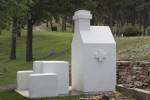 With Deadwood’s Chinese history decimated, the Deadwood Historic Preservation Commission decided to rebuild the altar and burner on the excavated concrete foundation. Using $31,105 from the Deadwood Historic Preservation fund, the altar was rebuilt with scrupulous attention to original detail according to the Secretary of Interior’s standards for reconstruction of historic properties. Researchers examined archaeological information from the dig and historic photographs to determine the exact size and dimensions of the altar and burner. The structure was then reconstructed using bricks salvaged from the Wing Tsue building.
With Deadwood’s Chinese history decimated, the Deadwood Historic Preservation Commission decided to rebuild the altar and burner on the excavated concrete foundation. Using $31,105 from the Deadwood Historic Preservation fund, the altar was rebuilt with scrupulous attention to original detail according to the Secretary of Interior’s standards for reconstruction of historic properties. Researchers examined archaeological information from the dig and historic photographs to determine the exact size and dimensions of the altar and burner. The structure was then reconstructed using bricks salvaged from the Wing Tsue building.
On Tuesday, July 23rd, the Deadwood Historic Preservation Committee, city leaders and descendants of Fee Lee Wong came together at Mt. Moriah Cemetery to celebrate the recreation of an important part of Chinese life in Deadwood.
Following brief remarks and a history of the project from Deadwood Historic Preservation Officer Kevin Kuchenbecker, Edith Wong invited the audience to take part in the first ceremonies at the altar of the Chinese burner. After the unveiling and the lighting of incense, a parade of participants took turns setting fake 100-million-yen notes ablaze in the burner, sending them to recipients in the afterlife.
“I’m sorry there’s no whole roasted pig in Deadwood today,” Wong said to a chorus of laughs as smoke wafted from the burner’s chimney.
Beatrice Wong, 82, said she was extremely pleased that clay bricks, salvaged from the Wing Tsue building that housed her grandfather’s modest empire, were used to reconstruct the Chinese burner. The historic Main Street building was demolished on Christmas Eve 2005.
“Chinatown was virtually wiped from the face of Deadwood,” she said. “Today, we replaced a piece of Chinese history in this town. We have deep gratitude to the Historic Preservation Commission and the people of Deadwood.”
Deadwood’s Chinese history was “decimated”? I’m not following.
Its material history. All that physically remains of the once-thriving community is a concrete slab in the cemetery and the shell of what was once the Hi Kee store. It’s been renovated to the studs, though, so it doesn’t look anything like it used to and now serves as the Deadwood Gulch Saloon. Decimation is too generous a term, actually, because it implies nine tenths survival and there are no surviving examples of Chinese life in Deadwood to speak of.
Nor are there many human remains of the Chinese community left behind, because the vast majority were only interred in Mt. Moriah Cemetery for a few years until all the soft tissues decayed. According to the Southern Chinese practice of reburial, their bones would then be exhumed, packed in metal or wooden boxes and shipped back to China via San Francisco.
Got it. I was thrown off by the word. Seemed much worse than one tenth, as you clarified. Thanks.
I should have known readers of this blog would read it as the precise Roman term more than the modern colloquial usage of “all but destroyed.” 😆
Do you know if there had been a joss house in Deadwood?
There was indeed. That’s where a gong was sounded to announce a death. It was also used a meeting house for the several Chinese fraternal organizations and for other religious ceremonies.
what the term & condition if i use one of your photos for movie making purpose? Thanks